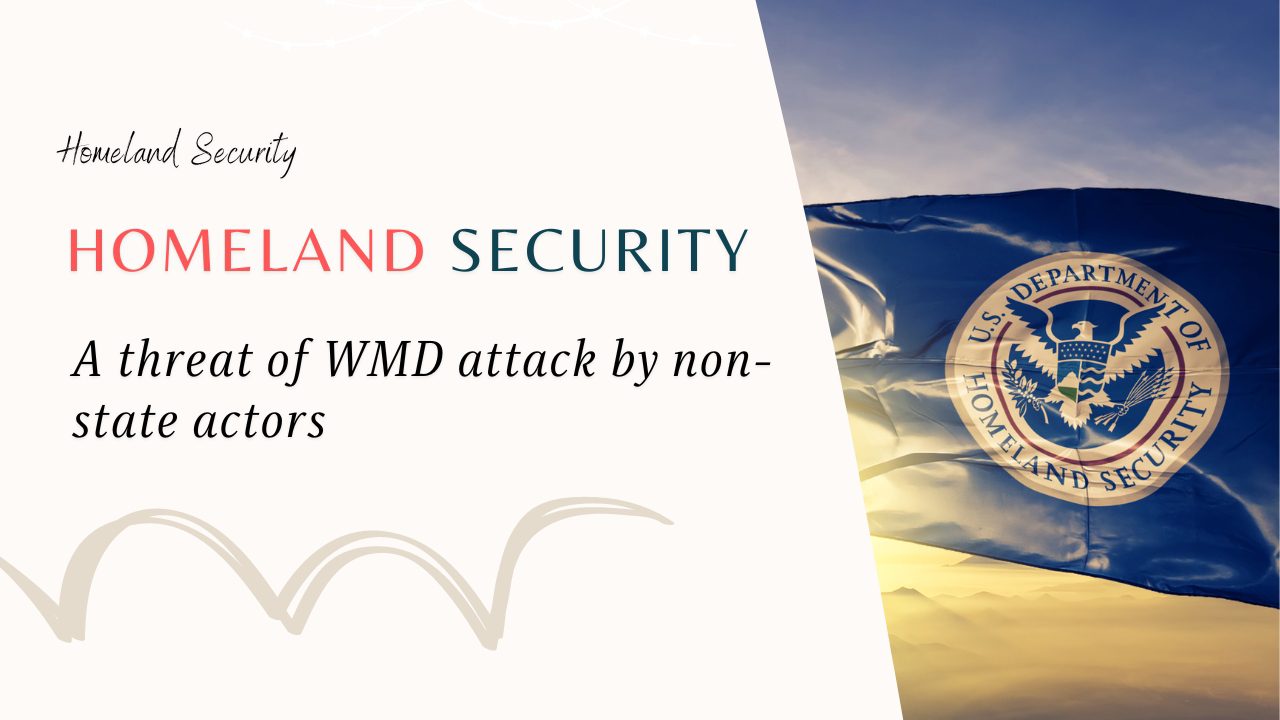a threat of WMD attack by non-state actors. To be sure, the United States retains a nuclear arsenal currently estimated at 6,970 warheads. While the threat of global nuclear armageddon is much reduced, the US keeps these weapons primarily as a deterrent against potentially hostile nations.
A threat of WMD attack by non-state actors
They’re of no use against non-state actors. Accordingly, the United States is party to agreements with other nations to reduce its stockpiles of WMD.
1992, US signed the Chemical Weapons Convention
In 1992, US signed the Chemical Weapons Convention requiring the destruction of all chemical stockpiles. The US expects to complete destruction of its chemical stockpile by 2020. The United States is also party to the 1972 Biological Weapons Convention, and retains no stockpiles of biological weapons. However, the US does continue to conduct research on biological weapons defense.
1968, the US signed the Nuclear Nonproliferation Treaty
In 1968, the US signed the Nuclear Nonproliferation Treaty to contain the spread of nuclear weapons, material, and technology. With the collapse of the Soviet Union in 1991, the US used the nonproliferation treaty to justify sending money and technicians to former Soviet republics to prevent the spread of nuclear weapons. After the Tokyo subway attacks, the justification shifted to keeping nukes off the black market and preventing them from falling into the hands of non-state actors.
In 1994, Congress commissioned a counter-proliferation program review committee, the CPRC, to report on the combined US effort to protect against WMD attack by non-state actors.
Current CPRC membership includes the
- Department of Defense
- Department of Energy
- Department of State
- the Office of the Director of National Intelligence
- The Joint Chiefs of Staff
- Department of Homeland Security.
Counter WMD strategy, as it is called, is comprised of three mission areas, nonproliferation, counterproliferation, and consequence management. Nonproliferation seeks to dissuade or impede both states and non-state actors from acquiring CBRN agents and weapons.
Counterproliferation seeks to develop both active and passive measures to deter and defend against the employment of CBRN weapons. Consequence management seeks to develop measures to quickly respond and recover against a domestic WMD attack. The Department of Defense practices counter proliferation by actively deterring potential hostile states and conducting special operations to retrieve loose materials.
DOD ( Department of Defense ) also plays a role in nonproliferation by overseeing the removal and sequestration of CBRN agents from the former Soviet republics under the Nunn-Lugar Global Cooperation Program.
DOD also supports consequence management by training and equipping National Guard Homeland Response Forces to respond to a domestic WMD attack.
The Department of Energy supports nonproliferation by keeping a close hold on the nation’s nuclear stockpile and technical information. And by developing the means to detect and track the movement of CBRN agents. The Department of Energy Nuclear Emergency Response Teams, or NERTS, stand ready to help search and diffuse nuclear and radiological weapons.
The State Department actively supports nonproliferation through the development and monitoring of treaties with other nations. The Director of National Intelligence collects, processes, and disseminates information related to counter WMD activities around the world. The ODNI provides support to the Department of Defense, Department of Energy, the Department of State and the Department of Homeland Security through three dedicated centers. One, the CBRN Counter Terrorism Group. Two, the National Counterproliferation Center and three, the National Counterterrorism Center.
Finally, the Department of Homeland Security also supports the three counter WMD mission sets. DHS supports nonproliferation by controlling and monitoring the passage of CBRN agents across US borders.
The DHS Domestic Nuclear Detection Office, DNDO, supports counterproliferation by improving the nation’s ability to detect the transportation of nuclear and radiological materials. And FEMA stands ready to coordinate federal assistance and support in response to a domestic WMD attack.
Let us review the main points from this article.
- WDM attack by non-state actors remains a substantive concern of national and homeland security.
- In 1994, Congress established the Counterproliferation Program Review Committee, CPRC, to maintain oversight and guide US counter WMD strategy.
- DHS is a member of the CPRC, together with DOD, DOE, the State Department, and the Director of National Intelligence.
- the nation’s counter WMD strategy is predicated on three mission areas, nonproliferation, counterproliferation, and consequence management.

